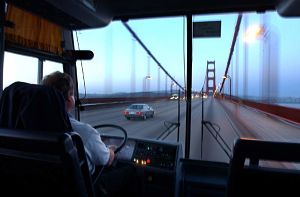“Finding a good bus driver can be as important as finding a good musician.”
Reba McEntire
If you’ve ever been to Pacific Heights area of San Francisco, California, you know the charm of Fillmore Street. This boutique chic, street is quintessentially SF trendy and has been for decades. If you know the street, you know Blue Bottle Coffee on the corner of Fillmore and Jackson. The place is the intersection of chic and coffee.
It was there, while seated outside, that I received a Master-level lesson in business management. My instructor was a San Francisco bus driver. His bus was on Jackson street about to make a right turn onto Fillmore. Parked cars lined both sides of crowded narrow street and an even narrowly tight turn.
As I sipped my French-press-pour the bus stopped. Immediately horns from cars in the rear blared in defiance of this interruption of movement and forward progress. The buss’s front doors hissed, heavy in response. Their compressor driven opening sighed, as if their metal doors resented having to do their job of opening and closing.
Out came, what came to be, my business guru-de-jour, the bus’s driver himself – in full uniform and authority. He’s definitely wearing one of uniforms for workers online. No wonder he looks so neat and respectable.
He expressed a Buddhist like calm and even-mindedness. He was intentioned and focused, despite the cacophony of honking resentment from car drivers behind him. Their glaring horns seemed to shout, “Who are you to hold us up, to block our progress and to slow us down? Don’t you know we’re in a hurry to get where we have to go? What makes you so very important to impede our progress?” One can easily imagine similar reactions coming other teams integrating into yours.
Even his passengers, we’ll call them his paying clients, craned the necks to look out the street side windows to see first-hand what all the commotion was about. They too seemed unsettled, even perplexed that their daily routines were jarred, by this unexplained, unannounced, unexpected and unchartered route stop.
I paused my sipping, choosing to focus on the street scene at hand, even against the loss of heat, taste and freshness of my now-not-so-fresh, deep dark, exotically-whatever, flavored bean, pour.
What was happening here? The bus driver was getting a better look at the clearance he needed to have, to make the turn he needed to make, to get his paying clients safely to the destinations they needed to get to and had paid him to get them there.
My mouth was agape. My lips separated as if my jaw muscles became unhinged. The driver was managing the potential risk of his course of action, despite resistance, disruption and obvious dislike for all around him.
Who does that these days? Who and how many, in middle and lower management roles does that, in your organization? Who takes time to evaluate risk even in the seemingly small and apparently not so significant things? As a driver of work initiatives, do you? Or do you leave risk management and quality assurance to upper management, or other teams, where you assume those management responsibilities lie?
All of us, regardless of our role title, drive production. Are we driving work by remote-somewhere-else-mind, by zombie mind, or by attention-to-detail-and -improvement mind? Are we paying attention to what’s happening in front of us and to the impact of unintended consequences of neglect may have to arriving at our destination on time and under cost?
Are you training your people to support risk management in the daily course of their work? Can you imagine if you did, what process improvements your front-line and mid management people could spot, suggest and pass on to you – to potential improve system flow integrity and profitability?
How much are we empowering our people to evaluate potential risks? How much are we even communicating that their considerations even matter? How much do our employees actually give a hoot and care about what they’re doing and how they’re doing their work? And if employee engagement and morale is low, whose responsibility exactly is that?
A bus driver, paid by the hour, stops his bus on a crowed street to assess the potential risk of a sharp turn amidst tightly parked cars in the direction of his turn?
He cares enough to stop what he’s doing to gain a better perspective of the future – so as to predict and adapt to it, without loss of time, cost and customer satisfaction. He’s operating strategically, though I’d bet he’s not trained to. But he’s leveraging a lean and agile method to a process approach that iteratively course corrects if needed – so as to avoid longer term deliver delays, low customer satisfaction and damaged transportation company, brand recognition.
He’s only a bus driver. Why should he be doing that? He shouldn’t be doing that. That’s not his role! Not in his job description or position accountabilities set, nope! Do you believe that?
That’s way more than a role responsibility of a bus driver in any city but; not for this bus driver. It’s why even though I don’t know him, I remember him. It’s why, even though I don’t know his name, I value his commitment to work product integrity, customer safety and satisfaction.
In a pumped-up, rushed-up world, that values a caffeine fueled urgency over quality control, this bus driver – is my Guru. What does this Guru tell you about you and how you and your people are driving the quality and commitment of their work production?
